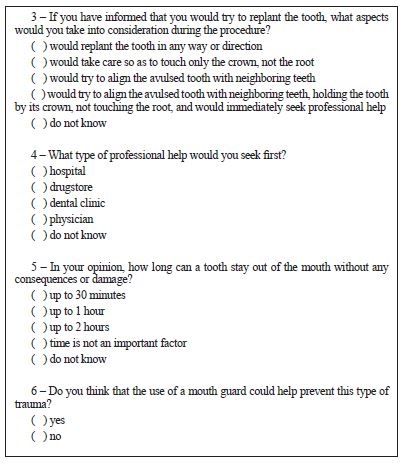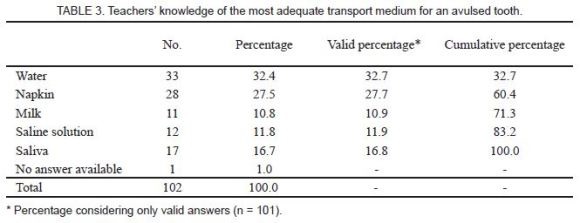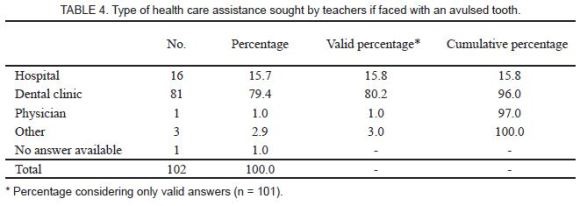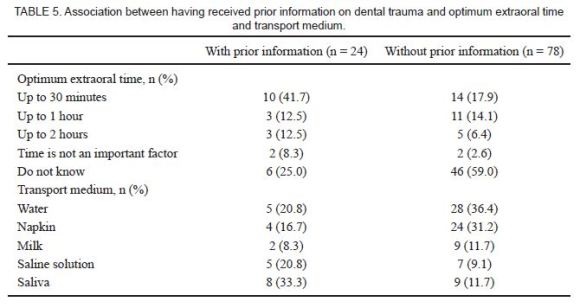Serviços Personalizados
Artigo
Links relacionados
Compartilhar
Stomatos
versão impressa ISSN 1519-4442
Stomatos vol.17 no.33 Canoas Jul./Dez. 2011
SCIENTIFIC ARTICLE
Knowledge of physical education teachers about emergency management of tooth avulsion
Conhecimento dos professores de educação física sobre o atendimento de emergência da avulsão dentária
Claudia Londero Pagliarin1; Clacir Londero Zenkner1; Fernando Branco Barletta2
1Assistents Professor of Faculty of Dentistry – UFSM, Brazil.
2Associate Professor of Course of Dentistry – ULBRA, Canoas/RS, Brazil.
ABSTRACT
A great number of traumatic dental injuries occur at school, during sports-related activities. However, physical education teachers are often not prepared to provide emergency management of dental trauma in general and of tooth avulsion in particular. The aim of this study was to assess the knowledge of emergency management of tooth avulsion among physical education teachers at public and private schools of a city in southern Brazil. A questionnaire covering personal and professional information and eight multiple-choice questions to assess knowledge of emergency management of tooth avulsion was sent to 217 physical education teachers. Of a total of 217 questionnaires distributed, 102 returned. Only 23.5% of the teachers had received prior information on dental trauma. When asked about the first action to be taken if faced with an avulsed tooth, only 12.7% informed they would attempt to replant the tooth. Fifty two teachers (51%) were not aware of the optimum extraoral time. Significant differences were found between teachers who had and who had not received prior information with regard to adequate transport medium and adequate time for replantation (chi-square, p = 0.03 and p = 0.02, respectively). There is a general lack of knowledge of emergency management of avulsed teeth among physical education teachers, pointing to an urgent need to implement regular, continuing education so as to increase the level of knowledge and improve prognosis of this important traumatic dental injury.
Keywords: Dental trauma, avulsion, knowledge, quality of life.
RESUMO
Grande parte dos traumatismos dentários ocorre no ambiente escolar durante a prática de esportes. Porém, os professores de educação física não estão preparados para fornecer o tratamento de emergência adequado, que é essencial para o prognóstico do dente avulsionado. O objetivo deste estudo foi investigar o conhecimento dos professores de educação física das escolas estaduais, municipais e particulares na cidade de Santa Maria-RS-Brasil sobre o atendimento de emergência da avulsão dentária. Um questionário avaliando o conhecimento dos professores de educação física foi distribuído a 217 professores. Um total de 102 (47%) questionários retornaram e foram analisados. Os resultados mostraram que apenas 23,5% dos professores já tinham recebido informações sobre traumatismo dentário. Quando questionados sobre os primeiros cuidados com o dente avulsionado, somente 12,7% tentariam reimplantar. Cinqüenta e dois professores (51%) não souberam por quanto tempo o dente pode permanecer fora do alvéolo sem causar danos às células do ligamento periodontal. O teste Qui-quadrado indicou uma diferença significante entre os professores que receberam ou não informação quanto ao tempo hábil para o reimplante (p=0,02). Fica evidente que há um inadequado conhecimento sobre o tratamento de urgência de dentes avulsionados. O estudo aponta para a necessidade de educação continuada para aumentar o conhecimento sobre o manejo de urgência de dentes avulsionados.
Palavras-chave: Trauma dental, avulsão, conhecimento, qualidade de vida.
INTRODUCTION
Dental trauma is a serious oral health problem and may cause both functional and esthetic problems, with possible impacts on the patient’s quality of life1,2. Most epidemiological studies show that a great number of traumatic dental injuries in schoolaged children occur either at home or at school, especially during physical education classes3-5.
Correct emergency management of dental trauma is essential for a good long-term prognosis, especially in cases of tooth avulsion6,7. Nevertheless, several studies, conducted in different countries, have reported a low level of knowledge of academic and physical education teachers with regard to the management of tooth avulsion8,9.
The objective of the present study was to assess the level of knowledge of physical education teachers working at public and private schools in a city in southern Brazil regarding the emergency management of tooth avulsion.
MATERIALS AND METHODS
The study protocol was approved by the Research Ethics Committee at Universidade Federal de Santa Maria, Brazil.
The present study was aimed at physical education teachers working at both public and private schools in the municipality of Santa Maria, a city with approximately 300,000 inhabitants located in the state of Rio Grande do Sul, southern Brazil. All participants received an envelope containing both a questionnaire and an informed consent form. All participants included in the study signed the consent form.
The survey was distributed to 217 physical education teachers. It comprised two parts: a first part with questions on professional and personal background, and a second part with eight multiple-choice questions assessing the teachers’ knowledge of emergency management of tooth avulsion (Table 1).


The schools were visited in person and the questionnaires were handed to the principals or people in charge of each school at the time of the visit. Principals who agreed to participate were informed of the study objectives, were asked to distribute the forms to all physical education teachers working at the school, and received instructions on how the questionnaires should be filled in. One week later, questionnaires were collected. Questionnaires were returned in a sealed and anonymous envelope.
Answers were revised and entered into spreadsheets. Results were analyzed using the Statistical Package for the Social Sciences (SPSS), version 18.0. The association between different questions and having or not received prior information on dental trauma was analyzed using the chi-square test. Significance was set at p < 0.05.
RESULTS
Of a total of 217 questionnaires distributed, 102 returned, at a response rate of 47%. Mean age was 45.76 years (range: 33 to 59 years). Mean length working as a teacher was 19.61 years.
Of the 102 respondents, only 24 (23.5%) reported to have received prior information on dental trauma. The sources of such information are described in Table 2.

In order to determine the level of knowledge of physical education teachers regarding emergency management of tooth avulsion, one question inquired the teachers about the fi rst action they would take if faced with a case of tooth avulsion. Most teachers informed that they would try to locate the avulsed tooth (56.9%); of the remainder, 15.7% would try to stop the bleeding with pressure, e.g. using a cloth, 12.7% would try to replant the tooth, 7.8% would call the child’s parents or guardians, and 6.9% would take the child to the dentist, not bothering about the avulsed tooth.
Table 3 shows the teachers’ knowledge about the best transport medium for an avulsed tooth whenever immediate replantation is not possible.

Of the teachers who informed that they would try to replant the tooth, 46.5% were not aware of the correct procedures that should be performed during eplantation, and 53.5% agreed with all the procedures suggested in the questionnaire.
Table 4 shows the type of professional help that physical education teachers would seek as a first option if faced with a case of tooth avulsion.

When asked about optimum extraoral time, 51% of the teachers (52) did not know the answer, 23.5% (24) informed 30 minutes to be an adequate amount of time, 13.7% (14) 1 hour, 7.8% (8) up to 2 hours, and 3.9% (4) believed that time was not an important issue in the management of avulsed teeth.
The use of mouth guards as a tool to prevent dental trauma was considered valid by 70.3% of the respondents; the remainder did not believe that such an initiative could have any impact on the prevention of sports-related trauma.
The chi-square test was used to assess associations between having received prior information on dental trauma and the different approaches described (p < 0.05). No statistically significant differences were observed between these two groups in terms of the first action if faced with an avulsed tooth (p = 0.70). Conversely, a statistically significant difference was found in relation to the medium selected to transport the avulsed tooth (p = 0.03): most teachers who had received prior information on dental trauma would transport the avulsed tooth immersed in saliva and water, compared with water or a napkin among teachers without prior information (Table 5).

Also, there were no significant differences between teachers with or without prior information on dental trauma with regard to the correct procedures to be performed during replantation (p = 0.20), the type of health care assistance sought (p = 0.64), and the use of mouth guards to prevent tooth avulsion (p = 0.44).
No significant association was observed either between the answers provided and the respondent’s age, time working as a teacher, or educational level (p > 0.05).
Finally, Table 5 shows a statistically significant difference between teachers with and without information with regard to the optimum extraoral time (p = 0.02).
DISCUSSION
The present study used a questionnaire to survey the level knowledge of physical education teachers regarding the emergency management of avulsed teeth in the city of Santa Maria, state of Rio Grande do Sul, southern Brazil. No study had so far been conducted in the region with the same objective. Our results revealed a low level of knowledge among the professionals assessed, which is in line with other studies conducted at different Brazilian states10-12.
The first aspect worthy of note in our study was our low response rate, of only 47%. One possible explanation for such a low participation is related to the way the survey was distributed: questionnaires were not distributed directly to the teachers; rather, they were handed to the schools’ principals, who in turn were asked to pass the forms on to the teachers. Previous studies using questionnaires directly applied to different groups of professionals have reported higher response rates10,13. In contrast, previous studies with a methodology similar to ours have obtained poor response rates14,15. Interestingly, among the schools who refused to participate in our study, one common reason for the principals’ decision was related to the absence of feedback by investigators conducting similar studies in the past.
Previous studies have indicated that educational initiatives aimed at teachers can positively influence their knowledge and attitudes regarding emergency management of dental trauma, consequently leading to a more favorable prognosis15. This finding underscores the urgent need to increase the knowledge of teachers about the recommended protocol for emergency management of traumatic dental injuries. In our study, only 23.5% of the teachers declared to have received prior information on dental trauma. However, there was no statistically significant difference in the number of correct answers given between teachers with and without prior information on dental trauma, which may be explained by the type of information covered and the teaching method employed in their training, or to the lack of regular, continuing education among these professionals. In fact, several authors have reported that providing teachers with information on dental trauma once only is not enough to promote adequate management of traumatic dental injuries9,16.
The prognosis of a traumatized tooth is highly dependent on an adequate emergency management. In cases of avulsed teeth, immediate replantation greatly increases the chances of a successful treatment outcome. In our study, the majority of teachers assessed (51%) were not aware of the optimum extraoral time, i.e. the length of time an avulsed tooth can stay out of the patient’s mouth without serious consequences or damage to the avulsed tooth. This finding is relevant once it widely known, among dental professionals, that the longer the time elapsed between avulsion and replantation, the higher the risk of replacement resorption and inflammatory root resorption6.
When immediate replantation is not possible, the tooth should be stored in an adequate transport medium so as to avoid damage to the periodontal ligament cells6. Our study showed that the majority of teachers (32.7%) would transport the tooth immersed in water. However, according to the specialized literature, tap water is the least desirable transport medium for an avulsed tooth, and should only be used when no other option is available, once it is a hypotonic medium and therefore can cause rapid cell lysis17,18. Also, when comparing teachers who had and who had not received prior information on dental trauma, our results showed that the first group tended to chose more adequate media, albeit not ideal, when compared with the group without prior information. Nevertheless, even in the group with prior information, only a minority of teachers chose milk as the avulsed tooth transport medium (8.3%), the best among the options presented in the questionnaire.
Milk is considered to be a practical transport medium, easily available and relatively free of bacteria. In addition, its osmolality is not excessively harmful to the periodontal ligament cells18. However, in our study, only 10.9% of the respondents would choose milk as the storage medium to transport the avulsed tooth. Blomlöf et al. compared milk and saliva as storage media and observed better results with the former17. Although saliva is among the recommended storage mediums for the transportation of avulsed teeth, it is the last option referred19. Saliva is also a hypotonic medium, and the additional presence of microorganisms may contribute to cell death.
Still regarding avulsed tooth transportation, perhaps the most disturbing finding of our study was the fact that a large number of teachers (27.7%) would choose a napkin to transport the tooth, as also reported before by Chan et al.9. These results reveal an important lack of knowledge, with high impacts in terms of long-term prognosis of avulsed teeth, once the choice of an adequate transport medium is essential to prevent damage to periodontal ligament cells and thus increase the chances of a successful treatment.
Another important aspect in the management of avulsed teeth is tooth manipulation. The avulsed tooth should be handled by the crown, not touching the root, avoiding contact with and possible damage to periodontal ligament cells6. Our survey showed that 46.5% of the physical education teachers did not know how to correctly handle an avulsed tooth. In the study of Frugeri & Costa20, of all the professionals who answered the authors’ survey, an average of 23% were not aware of the correct way to handle the tooth.
When asked about the type of professional help they would seek when faced with a case of tooth avulsion, a high rate of respondents informed that they would first seek help at a dental clinic (80.2%), and only 15.8% would take the patient to a hospital. This is a positive finding of our study, and it shows that the dental professional is considered by this group of teachers to have a better knowledge of the correct actions to be taken in a case of tooth avulsion when compared with other health care professionals.
The permanent loss of an avulsed tooth has both functional and psychological consequences. In 2009, Berger et al. conducted an investigation to assess the effect of severe dental trauma on the quality of life of both the affected children and their parents (21). The authors observed an immediate decrease in the family’s quality of life. The authors’ also found that one year after the traumatic event, children were still affected, primarily in terms of their social and emotional well-being.
In sum, our results confirm a general lack of knowledge of the emergency management of avulsed teeth among physical education teachers and add to the existing body of literature by providing information of such knowledge in southern Brazil.Considering the fact that these professionals are frequently exposed to traumatic dental injuries, our findings suggest an urgent need to implement a continuing education system as a tool to increase the chances of a good prognosis in this type of injury.
REFERENCES
1. Cortes MI, Marcenes W, Sheiham A. Impact of traumatic injuries to the permanent teeth on the oral health-related quality of life in 12-14-year-old children. Community Dent Oral Epidemiol. 2002;30(3):193-8. [ Links ]
2. Ramos-Jorge ML, Bosco VL, Peres MA, Nunes AC. The impact of treatment of dental trauma on the quality of life of adolescents - a case-control study in southern Brazil. Dent Traumatol. 2007;23(2):114-9. [ Links ]
3. García-Godoy F, Sánchez R, Sánchez JR. Traumatic dental injuries in a sample of Dominican schoolchildren. Community Dent Oral Epidemiol. 1981;9(4):193-7. [ Links ]
4. Gábris K, Tarján I, Rózsa N. Dental trauma in children presenting for treatment at the Department of Dentistry for Children and Orthodontics, Budapest, 1985-1999. Dent Traumatol. 2001;17(3):103-8. [ Links ]
5. Sgan-Cohen HD, Yassin H, Livny A. Dental trauma among 5th and 6th grade Arab schoolchildren in Eastern Jerusalem. Dent Traumatol. 2008;24(4):458-61. [ Links ]
6. Andreasen JO, Andreasen FM, Andersson L, editors. Textbook and color atlas of traumatic injuries to the teeth. 4th edn. Hoboken: Wiley-Blackwell; 2007. [ Links ]
7. Andreasen JO, Andreasen FM, Skeie A, Hjørting-Hansen E, Schwartz O. Effect of treatment delay upon pulp and periodontal healing of traumatic dental injuries -- a review article. Dent Traumatol. 2002;18(3):116-28. [ Links ]
8. Vergotine RJ, Govoni R. Public school educator’s knowledge of initial management of dental trauma. Dent Traumatol. 2010;26(2)133-6.
9. Chan AW, Wong TK, Cheung GS. Lay knowledge of physical education teachers about the emergency management of dental trauma in Hong Kong. Dent Traumatol. 2001;17(2):77-85. [ Links ]
10. Haragushiku GA, Faria MI, da Silva SR, Gonzaga CC, Baratto-Filho F. Knowledge and attitudes toward dental avulsion of public and private elementary schoolteachers. J Dent Child (Chic). 2010;77(1):49-53.
11. Panzarini SR, Pedrini D, Brandini DA, Poi WR, Santos MF, Correa JP, Silva FF. Physical education undergraduates and dental trauma knowledge. Dent Traumatol. 2005;21(6):324-8.
12. Mori GG, Turcio KH, Borro VP, Mariusso AM. Evaluation of the knowledge of tooth avulsion of school professionals from Adamantina, São Paulo, Brazil. Dent Traumatol. 2007;23(1):2-5.
13. Zhao Y, Gong Y. Knowledge of emergency management of avulsed teeth: a survey of dentists in Beijing, China. Dent Traumatol. 2010;26(3):281-4. [ Links ]
14. Holan G, Cohenca N, Brin I, Sgan-Cohen H. An oral health promotion program for the prevention of complications following avulsion: the effect on knowledge of physical education teachers. Dent Traumatol. 2006;22(6):323-7. [ Links ]
15. Lieger O, Graf C, El-Maaytah M, Von Arx T. Impact of educational posters on the lay knowledge of school teachers regarding emergency management of dental injuries. Dent Traumatol. 2009;25(4):406-12. [ Links ]
16. Blakytny C, Surbuts C, Thomas A, Hunter ML. Avulsed permanent incisors: knowledge and attitudes of primary school teachers with regard to emergency management. Int J Paediatr Dent. 2001;11(5):327-32. [ Links ]
17. Blomlöf L, Otteskog P, Hammarström L. Effect of storage in media with differention strengths and osmolalities on human periodontal ligament cells. Scand J Dent Res. 1981;89(2)180-7. [ Links ]
18. Trope M. Clinical management of the avulsed tooth: present strategies and future directions. Dent Traumatol. 2002;18(1):1-11. [ Links ]
19. Trope M. Clinical management of the avulsed tooth. Dent Clin North Am. 1995;39(1):93-112. [ Links ]
20. Frujeri ME, Costa ED. Effect of a single dental health education on the management of permanent avulsed teeth by different groups of professionals. Dent Traumatol. 2009;25(3):262-71. [ Links ]
21. Berger TD, Kenny DJ, Casas MJ, Barrett EJ, Lawrence HP. Effects of severe dentoalveolar trauma on the quality-of-life of children and parents. Dent Traumatol. 2009;25(5):462-9. [ Links ]
 Corresponding Author:
Corresponding Author:
Claudia Londero Pagliarin
Faculty of Dentistry – UFSM
Rua Av. Medianeira 1782 sala 01 – Centro
CEP 97060002. Santa Maria/RS – Brasil
Tel.: (55) 3028.3530
E-mail:clpagliarin@gmail.com













